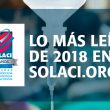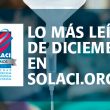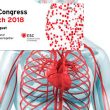1- The CULPRIT-SHOCK Study Is Finally Published in NEJM and It Is Bound to Change Guidelines During SOLACI’s coverage of the TCT 2017 Congress in Denver, Colorado, we already mentioned some of the outcomes of this study that has arrived to revolutionize clinical practice, given the differences between its results and those of the classic<a href="https://solaci.org/en/2019/01/11/these-were-the-most-relevant-article-of-2018-in-the-field-of-coronary-diseases/" title="Read more" >...</a>
The 10 most consulted articles at SOLACI during 2018
1- New High Blood Pressure Guidelines The wait is finally over: the high blood pressure guidelines that have been in the works for the past 3 years saw the light of day at the American Heart Association (AHA) 2017 Scientific Sessions. Read more 2- The 10 Commandments of ESC’s New STEMI Guidelines The authors<a href="https://solaci.org/en/2019/01/08/the-10-most-consulted-articles-at-solaci-during-2018/" title="Read more" >...</a>
Acute Coronary Syndromes After TAVR: Frequent and Not All Undergo Coronary Angiography
Approximately 10% of patients who undergo transcatheter aortic valve replacement (TAVR) are readmitted for an acute coronary syndrome after a mean follow-up of 25 months. Male sex, prior coronary artery disease, and (surprisingly and hard to explain) nontransfemoral approach were independent predictors of acute coronary syndrome after TAVR, an event associated with high midterm mortality. While<a href="https://solaci.org/en/2019/01/04/acute-coronary-syndromes-after-tavr-frequent-and-not-all-undergo-coronary-angiography/" title="Read more" >...</a>
The 10 Most Read Articles of December
1- Everolimus-Eluting Stents Finally Have a Rival and Not Just a “Non-Inferior” Stent In this large randomized trial, there were significant differences as regards both target-lesion failure and target-vessel-related infarction, which persisted through a 2-year follow-up and favored treatment with an ultrathin-strut bioresorbable-polymer sirolimus-eluting stent (Orsiro) compared with the gold standard, a durable-polymer everolimus-eluting stent<a href="https://solaci.org/en/2019/01/04/the-10-most-read-articles-of-december/" title="Read more" >...</a>
Balloon-Expandable vs. Self-Expanding: To Each Valve Its Own Annulus
The former generation of valves, the balloon expandable (Sapien XT), was associated to less paravalvular leak than the self-expanding valves only in patients with larger annuli. The new generation of self-expanding valves (Evolut R) has managed to significantly improve sealing in patients with larger annuli and still holds potential benefits for smaller annuli. The aim<a href="https://solaci.org/en/2018/12/28/balloon-expandable-vs-self-expanding-to-each-valve-its-own-annulus/" title="Read more" >...</a>
AHA 2018 | New-Generation DES Are Similar to Second-Generation DES Beyond Polymer
Sirolimus-eluting stents with biodegradable polymer did not offer better outcomes compared with instant-classic (and undoubtedly valid) everolimus-eluting stents with durable polymer such as Xience. New-generation drug-eluting stents (DES) offer better outcomes than first-generation devices after a 10-year follow-up, according to the ISAR-TEST 4 trial presented at the American Heart Association (AHA) Congress Scientific Sessions and published<a href="https://solaci.org/en/2018/11/30/aha-2018-new-generation-des-are-similar-to-second-generation-des-beyond-polymer/" title="Read more" >...</a>
AHA 2018 | No Benefits with Methothrexate as Anti-Inflammatory Drug
Low-dose methotrexate (a nonspecific anti-inflammatory agent used for the treatment of rheumatoid arthritis and other autoimmune disorders) did not prevent cardiovascular events in patients with a prior infarction or multivessel coronary artery disease, according to this study presented at the American Heart Association (AHA) Congress and published simultaneously in the New England Journal of Medicine<a href="https://solaci.org/en/2018/11/28/aha-2018-no-benefits-with-methothrexate-as-anti-inflammatory-drug/" title="Read more" >...</a>
AHA 2018 | Freedom Long-Term Follow-up: Still in Favor of CABG
Nearly 8 years later, CABG maintains its benefit over PCI-DES in terms of mortality in diabetic patients with multivessel disease, according to the Freedom trial, presented by Dr. Fuster at AHA and simultaneously published in JACC. CABG is superior to PCI-DES, with 36% higher mortality in these last years. Considering the nature of atherosclerosis,<a href="https://solaci.org/en/2018/11/27/aha-2018-freedom-long-term-follow-up-still-in-favor-of-cabg/" title="Read more" >...</a>
Complete Revascularization Improves Long-Term Prognosis in Acute Coronary Syndromes
Going beyond the culprit artery during angioplasty was associated with lower mortality, although this was a cohort study that should be confirmed through randomized trials. According to this new observational study, patients experiencing non-ST-segment elevation myocardial infarction with multivessel disease seem to benefit from complete revascularization during initial angioplasty. This study, published online before<a href="https://solaci.org/en/2018/11/01/complete-revascularization-improves-long-term-prognosis-in-acute-coronary-syndromes/" title="Read more" >...</a>
ESC 2018 | CULPRIT-SHOCK: 1-Year Results Continue to Support Treatment of the Culprit Artery Only
Increases in the rates of revascularization and heart failure do not justify the early mortality advantage shown by treatment of the culprit artery only in patients with acute myocardial infarction and cardiogenic shock. The 1-year follow-up of the CULPRIT-SHOCK trial reinforces the idea of only treating the culprit artery, with an option for revascularization of<a href="https://solaci.org/en/2018/08/28/esc-2018-culprit-shock-1-year-results-continue-to-support-treatment-of-the-culprit-artery-only/" title="Read more" >...</a>









